Constructivism Theory and its Linkage with Sexualities in Social Work
VerifiedAdded on 2023/01/19
|17
|4124
|77
AI Summary
This paper explores the relationship between constructivism theory and sexualities in the field of social work. It discusses how constructivism theory influences the understanding and training of social workers in dealing with diverse sexual orientations. The paper also examines the history and principles of constructivism theory, as well as its criticisms. Additionally, it explores the concept of sexualities and the link between constructivism theory and sexualities. The paper concludes by discussing the role of constructivism theory in sexuality training and its impact on fighting for justice for sexual minorities.
Contribute Materials
Your contribution can guide someone’s learning journey. Share your
documents today.

Running head: MANAGEMENT 1
Social work
Student Name
Institution
Social work
Student Name
Institution
Secure Best Marks with AI Grader
Need help grading? Try our AI Grader for instant feedback on your assignments.
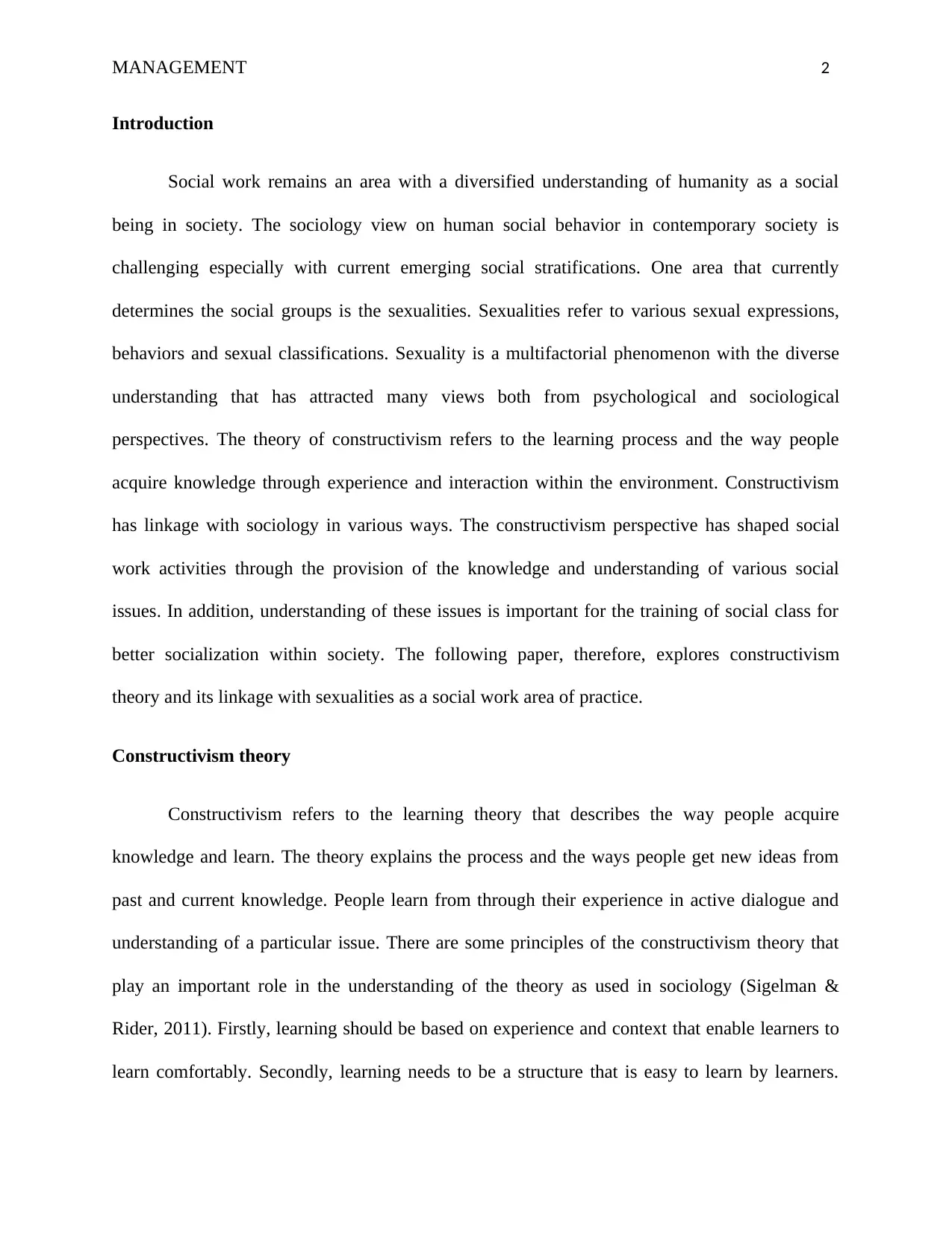
MANAGEMENT 2
Introduction
Social work remains an area with a diversified understanding of humanity as a social
being in society. The sociology view on human social behavior in contemporary society is
challenging especially with current emerging social stratifications. One area that currently
determines the social groups is the sexualities. Sexualities refer to various sexual expressions,
behaviors and sexual classifications. Sexuality is a multifactorial phenomenon with the diverse
understanding that has attracted many views both from psychological and sociological
perspectives. The theory of constructivism refers to the learning process and the way people
acquire knowledge through experience and interaction within the environment. Constructivism
has linkage with sociology in various ways. The constructivism perspective has shaped social
work activities through the provision of the knowledge and understanding of various social
issues. In addition, understanding of these issues is important for the training of social class for
better socialization within society. The following paper, therefore, explores constructivism
theory and its linkage with sexualities as a social work area of practice.
Constructivism theory
Constructivism refers to the learning theory that describes the way people acquire
knowledge and learn. The theory explains the process and the ways people get new ideas from
past and current knowledge. People learn from through their experience in active dialogue and
understanding of a particular issue. There are some principles of the constructivism theory that
play an important role in the understanding of the theory as used in sociology (Sigelman &
Rider, 2011). Firstly, learning should be based on experience and context that enable learners to
learn comfortably. Secondly, learning needs to be a structure that is easy to learn by learners.
Introduction
Social work remains an area with a diversified understanding of humanity as a social
being in society. The sociology view on human social behavior in contemporary society is
challenging especially with current emerging social stratifications. One area that currently
determines the social groups is the sexualities. Sexualities refer to various sexual expressions,
behaviors and sexual classifications. Sexuality is a multifactorial phenomenon with the diverse
understanding that has attracted many views both from psychological and sociological
perspectives. The theory of constructivism refers to the learning process and the way people
acquire knowledge through experience and interaction within the environment. Constructivism
has linkage with sociology in various ways. The constructivism perspective has shaped social
work activities through the provision of the knowledge and understanding of various social
issues. In addition, understanding of these issues is important for the training of social class for
better socialization within society. The following paper, therefore, explores constructivism
theory and its linkage with sexualities as a social work area of practice.
Constructivism theory
Constructivism refers to the learning theory that describes the way people acquire
knowledge and learn. The theory explains the process and the ways people get new ideas from
past and current knowledge. People learn from through their experience in active dialogue and
understanding of a particular issue. There are some principles of the constructivism theory that
play an important role in the understanding of the theory as used in sociology (Sigelman &
Rider, 2011). Firstly, learning should be based on experience and context that enable learners to
learn comfortably. Secondly, learning needs to be a structure that is easy to learn by learners.
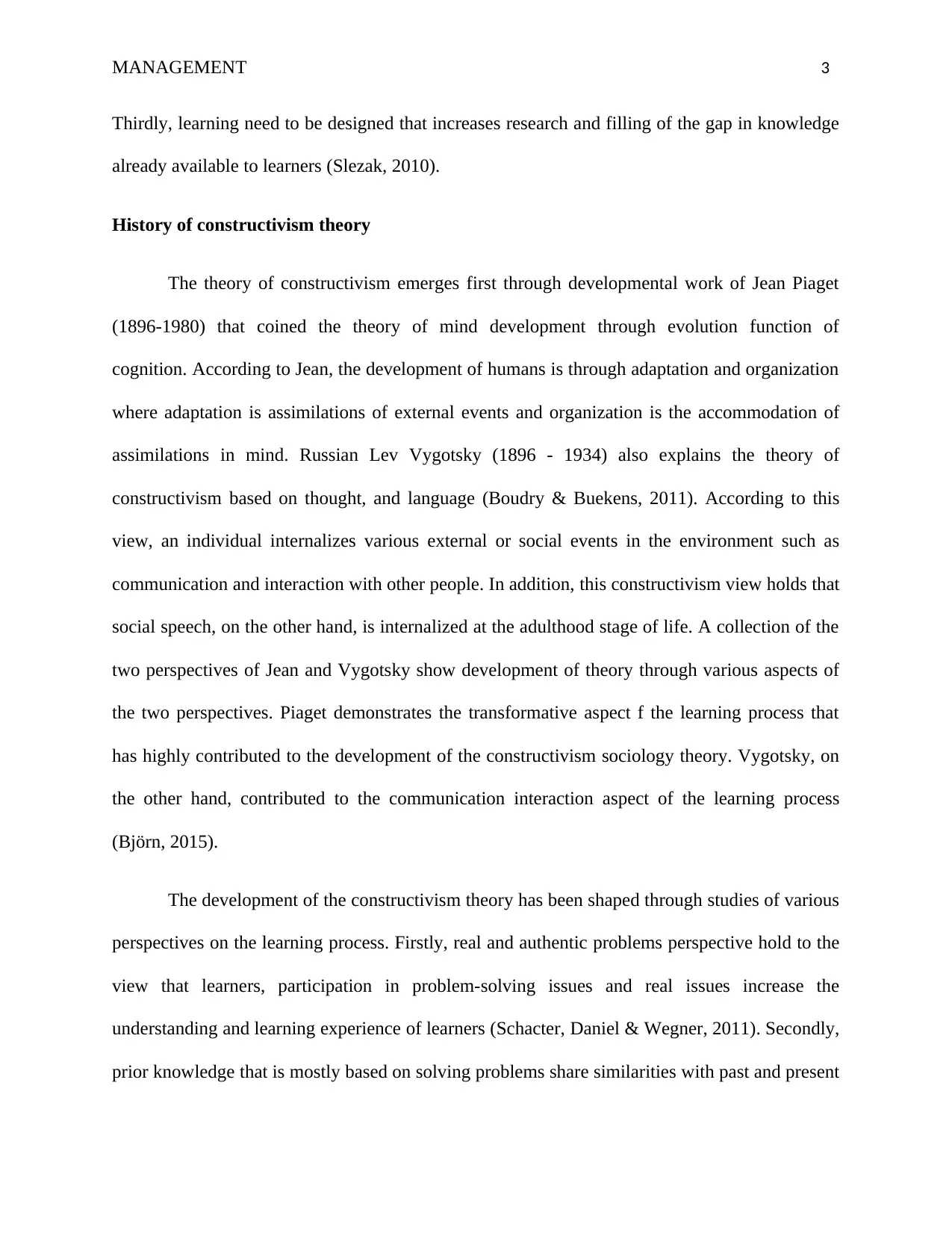
MANAGEMENT 3
Thirdly, learning need to be designed that increases research and filling of the gap in knowledge
already available to learners (Slezak, 2010).
History of constructivism theory
The theory of constructivism emerges first through developmental work of Jean Piaget
(1896-1980) that coined the theory of mind development through evolution function of
cognition. According to Jean, the development of humans is through adaptation and organization
where adaptation is assimilations of external events and organization is the accommodation of
assimilations in mind. Russian Lev Vygotsky (1896 - 1934) also explains the theory of
constructivism based on thought, and language (Boudry & Buekens, 2011). According to this
view, an individual internalizes various external or social events in the environment such as
communication and interaction with other people. In addition, this constructivism view holds that
social speech, on the other hand, is internalized at the adulthood stage of life. A collection of the
two perspectives of Jean and Vygotsky show development of theory through various aspects of
the two perspectives. Piaget demonstrates the transformative aspect f the learning process that
has highly contributed to the development of the constructivism sociology theory. Vygotsky, on
the other hand, contributed to the communication interaction aspect of the learning process
(Björn, 2015).
The development of the constructivism theory has been shaped through studies of various
perspectives on the learning process. Firstly, real and authentic problems perspective hold to the
view that learners, participation in problem-solving issues and real issues increase the
understanding and learning experience of learners (Schacter, Daniel & Wegner, 2011). Secondly,
prior knowledge that is mostly based on solving problems share similarities with past and present
Thirdly, learning need to be designed that increases research and filling of the gap in knowledge
already available to learners (Slezak, 2010).
History of constructivism theory
The theory of constructivism emerges first through developmental work of Jean Piaget
(1896-1980) that coined the theory of mind development through evolution function of
cognition. According to Jean, the development of humans is through adaptation and organization
where adaptation is assimilations of external events and organization is the accommodation of
assimilations in mind. Russian Lev Vygotsky (1896 - 1934) also explains the theory of
constructivism based on thought, and language (Boudry & Buekens, 2011). According to this
view, an individual internalizes various external or social events in the environment such as
communication and interaction with other people. In addition, this constructivism view holds that
social speech, on the other hand, is internalized at the adulthood stage of life. A collection of the
two perspectives of Jean and Vygotsky show development of theory through various aspects of
the two perspectives. Piaget demonstrates the transformative aspect f the learning process that
has highly contributed to the development of the constructivism sociology theory. Vygotsky, on
the other hand, contributed to the communication interaction aspect of the learning process
(Björn, 2015).
The development of the constructivism theory has been shaped through studies of various
perspectives on the learning process. Firstly, real and authentic problems perspective hold to the
view that learners, participation in problem-solving issues and real issues increase the
understanding and learning experience of learners (Schacter, Daniel & Wegner, 2011). Secondly,
prior knowledge that is mostly based on solving problems share similarities with past and present
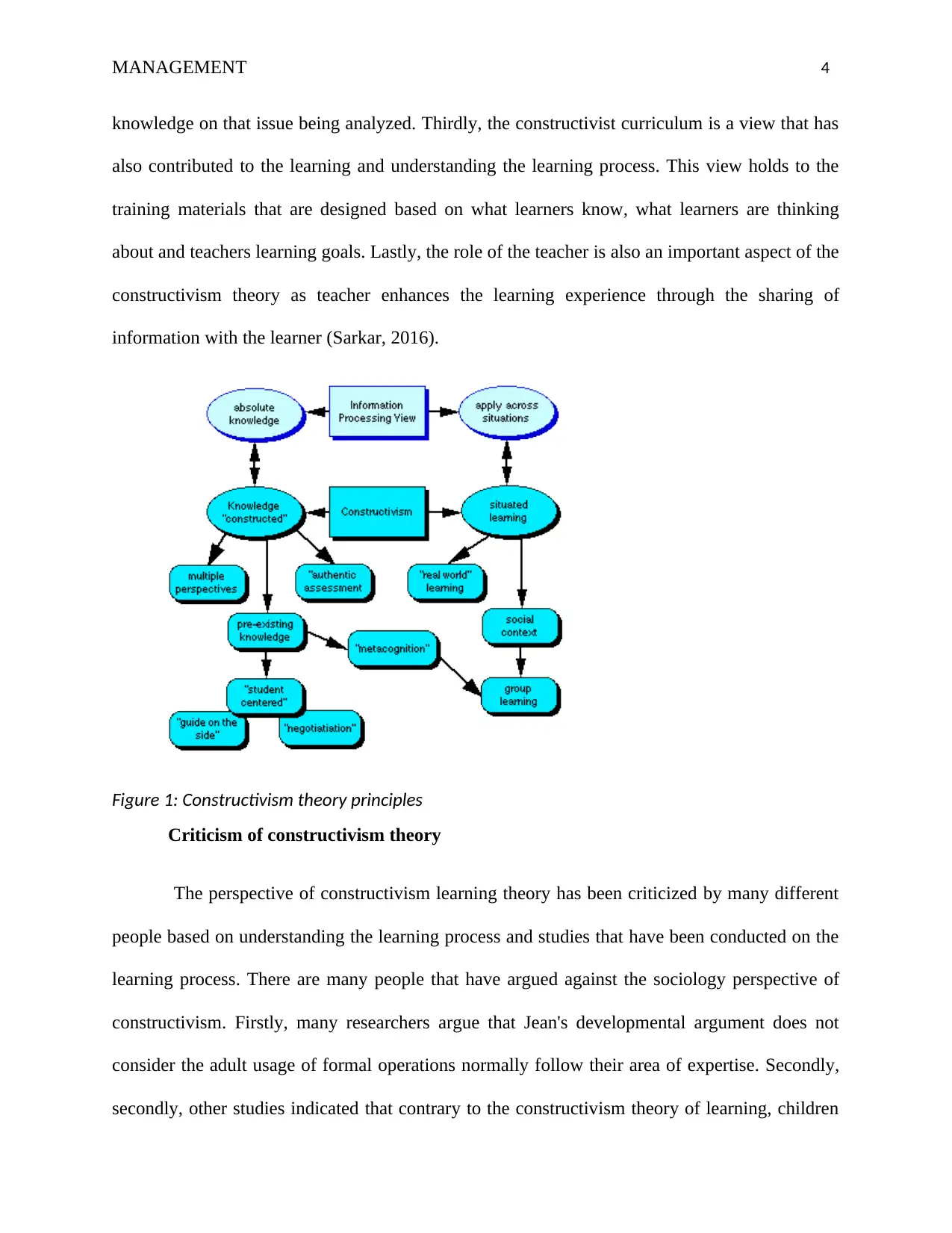
MANAGEMENT 4
knowledge on that issue being analyzed. Thirdly, the constructivist curriculum is a view that has
also contributed to the learning and understanding the learning process. This view holds to the
training materials that are designed based on what learners know, what learners are thinking
about and teachers learning goals. Lastly, the role of the teacher is also an important aspect of the
constructivism theory as teacher enhances the learning experience through the sharing of
information with the learner (Sarkar, 2016).
Figure 1: Constructivism theory principles
Criticism of constructivism theory
The perspective of constructivism learning theory has been criticized by many different
people based on understanding the learning process and studies that have been conducted on the
learning process. There are many people that have argued against the sociology perspective of
constructivism. Firstly, many researchers argue that Jean's developmental argument does not
consider the adult usage of formal operations normally follow their area of expertise. Secondly,
secondly, other studies indicated that contrary to the constructivism theory of learning, children
knowledge on that issue being analyzed. Thirdly, the constructivist curriculum is a view that has
also contributed to the learning and understanding the learning process. This view holds to the
training materials that are designed based on what learners know, what learners are thinking
about and teachers learning goals. Lastly, the role of the teacher is also an important aspect of the
constructivism theory as teacher enhances the learning experience through the sharing of
information with the learner (Sarkar, 2016).
Figure 1: Constructivism theory principles
Criticism of constructivism theory
The perspective of constructivism learning theory has been criticized by many different
people based on understanding the learning process and studies that have been conducted on the
learning process. There are many people that have argued against the sociology perspective of
constructivism. Firstly, many researchers argue that Jean's developmental argument does not
consider the adult usage of formal operations normally follow their area of expertise. Secondly,
secondly, other studies indicated that contrary to the constructivism theory of learning, children
Secure Best Marks with AI Grader
Need help grading? Try our AI Grader for instant feedback on your assignments.
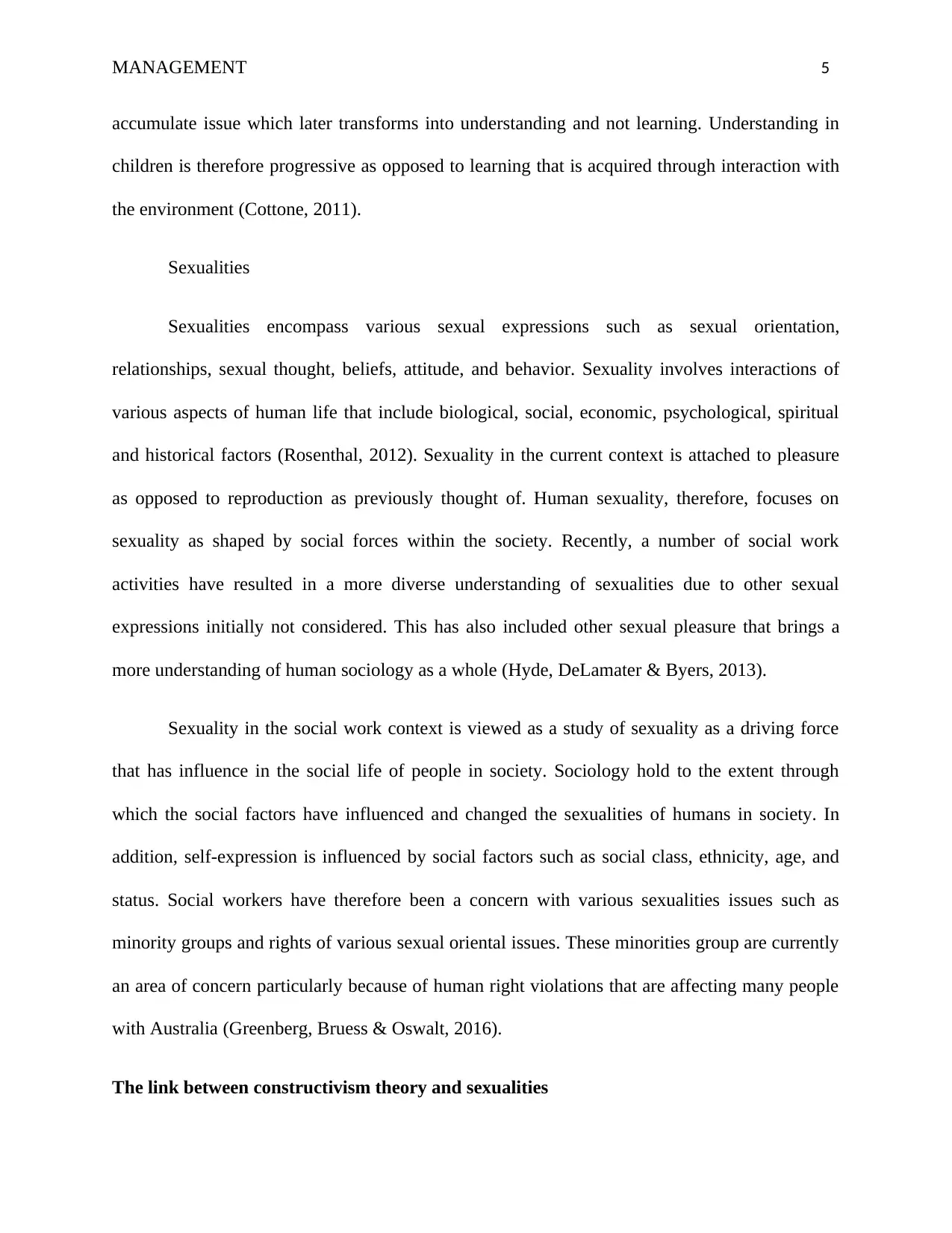
MANAGEMENT 5
accumulate issue which later transforms into understanding and not learning. Understanding in
children is therefore progressive as opposed to learning that is acquired through interaction with
the environment (Cottone, 2011).
Sexualities
Sexualities encompass various sexual expressions such as sexual orientation,
relationships, sexual thought, beliefs, attitude, and behavior. Sexuality involves interactions of
various aspects of human life that include biological, social, economic, psychological, spiritual
and historical factors (Rosenthal, 2012). Sexuality in the current context is attached to pleasure
as opposed to reproduction as previously thought of. Human sexuality, therefore, focuses on
sexuality as shaped by social forces within the society. Recently, a number of social work
activities have resulted in a more diverse understanding of sexualities due to other sexual
expressions initially not considered. This has also included other sexual pleasure that brings a
more understanding of human sociology as a whole (Hyde, DeLamater & Byers, 2013).
Sexuality in the social work context is viewed as a study of sexuality as a driving force
that has influence in the social life of people in society. Sociology hold to the extent through
which the social factors have influenced and changed the sexualities of humans in society. In
addition, self-expression is influenced by social factors such as social class, ethnicity, age, and
status. Social workers have therefore been a concern with various sexualities issues such as
minority groups and rights of various sexual oriental issues. These minorities group are currently
an area of concern particularly because of human right violations that are affecting many people
with Australia (Greenberg, Bruess & Oswalt, 2016).
The link between constructivism theory and sexualities
accumulate issue which later transforms into understanding and not learning. Understanding in
children is therefore progressive as opposed to learning that is acquired through interaction with
the environment (Cottone, 2011).
Sexualities
Sexualities encompass various sexual expressions such as sexual orientation,
relationships, sexual thought, beliefs, attitude, and behavior. Sexuality involves interactions of
various aspects of human life that include biological, social, economic, psychological, spiritual
and historical factors (Rosenthal, 2012). Sexuality in the current context is attached to pleasure
as opposed to reproduction as previously thought of. Human sexuality, therefore, focuses on
sexuality as shaped by social forces within the society. Recently, a number of social work
activities have resulted in a more diverse understanding of sexualities due to other sexual
expressions initially not considered. This has also included other sexual pleasure that brings a
more understanding of human sociology as a whole (Hyde, DeLamater & Byers, 2013).
Sexuality in the social work context is viewed as a study of sexuality as a driving force
that has influence in the social life of people in society. Sociology hold to the extent through
which the social factors have influenced and changed the sexualities of humans in society. In
addition, self-expression is influenced by social factors such as social class, ethnicity, age, and
status. Social workers have therefore been a concern with various sexualities issues such as
minority groups and rights of various sexual oriental issues. These minorities group are currently
an area of concern particularly because of human right violations that are affecting many people
with Australia (Greenberg, Bruess & Oswalt, 2016).
The link between constructivism theory and sexualities
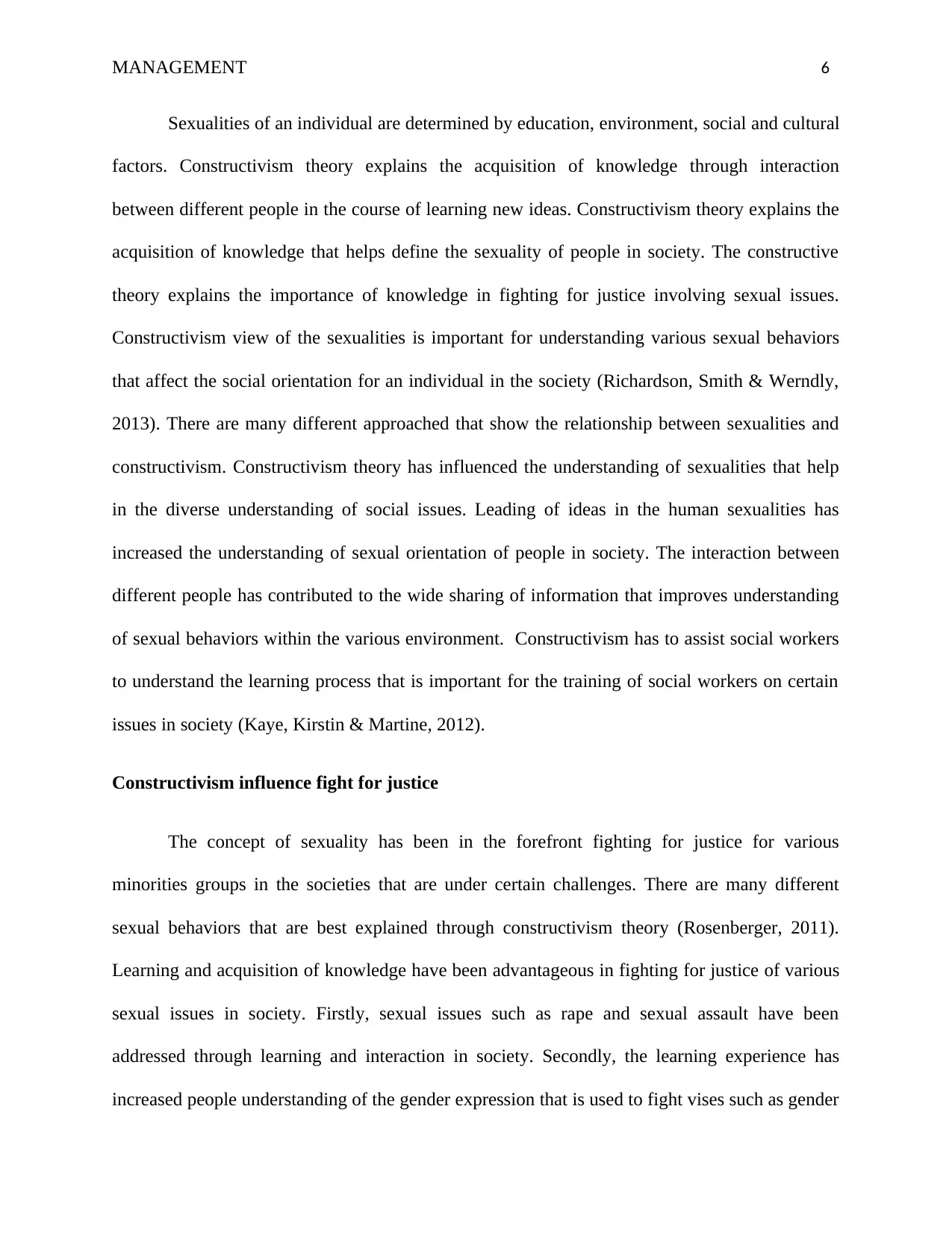
MANAGEMENT 6
Sexualities of an individual are determined by education, environment, social and cultural
factors. Constructivism theory explains the acquisition of knowledge through interaction
between different people in the course of learning new ideas. Constructivism theory explains the
acquisition of knowledge that helps define the sexuality of people in society. The constructive
theory explains the importance of knowledge in fighting for justice involving sexual issues.
Constructivism view of the sexualities is important for understanding various sexual behaviors
that affect the social orientation for an individual in the society (Richardson, Smith & Werndly,
2013). There are many different approached that show the relationship between sexualities and
constructivism. Constructivism theory has influenced the understanding of sexualities that help
in the diverse understanding of social issues. Leading of ideas in the human sexualities has
increased the understanding of sexual orientation of people in society. The interaction between
different people has contributed to the wide sharing of information that improves understanding
of sexual behaviors within the various environment. Constructivism has to assist social workers
to understand the learning process that is important for the training of social workers on certain
issues in society (Kaye, Kirstin & Martine, 2012).
Constructivism influence fight for justice
The concept of sexuality has been in the forefront fighting for justice for various
minorities groups in the societies that are under certain challenges. There are many different
sexual behaviors that are best explained through constructivism theory (Rosenberger, 2011).
Learning and acquisition of knowledge have been advantageous in fighting for justice of various
sexual issues in society. Firstly, sexual issues such as rape and sexual assault have been
addressed through learning and interaction in society. Secondly, the learning experience has
increased people understanding of the gender expression that is used to fight vises such as gender
Sexualities of an individual are determined by education, environment, social and cultural
factors. Constructivism theory explains the acquisition of knowledge through interaction
between different people in the course of learning new ideas. Constructivism theory explains the
acquisition of knowledge that helps define the sexuality of people in society. The constructive
theory explains the importance of knowledge in fighting for justice involving sexual issues.
Constructivism view of the sexualities is important for understanding various sexual behaviors
that affect the social orientation for an individual in the society (Richardson, Smith & Werndly,
2013). There are many different approached that show the relationship between sexualities and
constructivism. Constructivism theory has influenced the understanding of sexualities that help
in the diverse understanding of social issues. Leading of ideas in the human sexualities has
increased the understanding of sexual orientation of people in society. The interaction between
different people has contributed to the wide sharing of information that improves understanding
of sexual behaviors within the various environment. Constructivism has to assist social workers
to understand the learning process that is important for the training of social workers on certain
issues in society (Kaye, Kirstin & Martine, 2012).
Constructivism influence fight for justice
The concept of sexuality has been in the forefront fighting for justice for various
minorities groups in the societies that are under certain challenges. There are many different
sexual behaviors that are best explained through constructivism theory (Rosenberger, 2011).
Learning and acquisition of knowledge have been advantageous in fighting for justice of various
sexual issues in society. Firstly, sexual issues such as rape and sexual assault have been
addressed through learning and interaction in society. Secondly, the learning experience has
increased people understanding of the gender expression that is used to fight vises such as gender
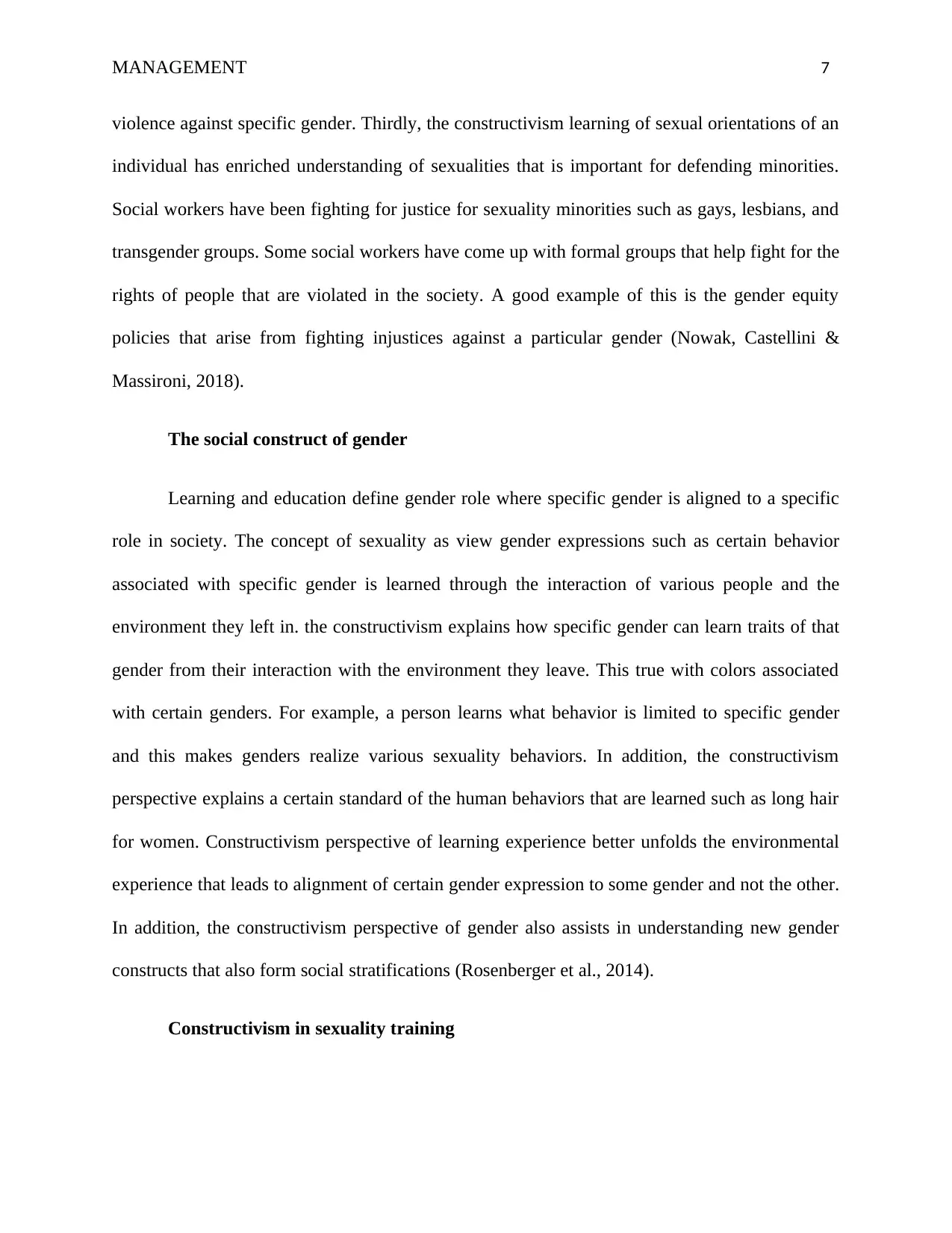
MANAGEMENT 7
violence against specific gender. Thirdly, the constructivism learning of sexual orientations of an
individual has enriched understanding of sexualities that is important for defending minorities.
Social workers have been fighting for justice for sexuality minorities such as gays, lesbians, and
transgender groups. Some social workers have come up with formal groups that help fight for the
rights of people that are violated in the society. A good example of this is the gender equity
policies that arise from fighting injustices against a particular gender (Nowak, Castellini &
Massironi, 2018).
The social construct of gender
Learning and education define gender role where specific gender is aligned to a specific
role in society. The concept of sexuality as view gender expressions such as certain behavior
associated with specific gender is learned through the interaction of various people and the
environment they left in. the constructivism explains how specific gender can learn traits of that
gender from their interaction with the environment they leave. This true with colors associated
with certain genders. For example, a person learns what behavior is limited to specific gender
and this makes genders realize various sexuality behaviors. In addition, the constructivism
perspective explains a certain standard of the human behaviors that are learned such as long hair
for women. Constructivism perspective of learning experience better unfolds the environmental
experience that leads to alignment of certain gender expression to some gender and not the other.
In addition, the constructivism perspective of gender also assists in understanding new gender
constructs that also form social stratifications (Rosenberger et al., 2014).
Constructivism in sexuality training
violence against specific gender. Thirdly, the constructivism learning of sexual orientations of an
individual has enriched understanding of sexualities that is important for defending minorities.
Social workers have been fighting for justice for sexuality minorities such as gays, lesbians, and
transgender groups. Some social workers have come up with formal groups that help fight for the
rights of people that are violated in the society. A good example of this is the gender equity
policies that arise from fighting injustices against a particular gender (Nowak, Castellini &
Massironi, 2018).
The social construct of gender
Learning and education define gender role where specific gender is aligned to a specific
role in society. The concept of sexuality as view gender expressions such as certain behavior
associated with specific gender is learned through the interaction of various people and the
environment they left in. the constructivism explains how specific gender can learn traits of that
gender from their interaction with the environment they leave. This true with colors associated
with certain genders. For example, a person learns what behavior is limited to specific gender
and this makes genders realize various sexuality behaviors. In addition, the constructivism
perspective explains a certain standard of the human behaviors that are learned such as long hair
for women. Constructivism perspective of learning experience better unfolds the environmental
experience that leads to alignment of certain gender expression to some gender and not the other.
In addition, the constructivism perspective of gender also assists in understanding new gender
constructs that also form social stratifications (Rosenberger et al., 2014).
Constructivism in sexuality training
Paraphrase This Document
Need a fresh take? Get an instant paraphrase of this document with our AI Paraphraser

MANAGEMENT 8
The constructivism perspective of the sociology has been used to training various social
workers in the sexualities. Learning and acquisition of knowledge have been used to train
various people on the importance of sexual orientation of an individual in society. Sexuality
education is an aspect of sexual training that focuses on the training of youth on sexual
orientation. Sexuality education also increases the awareness of sexual changes of the that occurs
in people especially during adolescences and post adolescences. One area that many social
workers are being trained on is sexuality counseling that helps advice people in the society faced
with sexual orientation challenges. For instance, accepting one's sexual orientation need
counseling of people involved. Moreover, people at different age brackets need specific
developmental sexuality training to help them understand certain social issues. A human being is
social and each stage of life requires counseling or learning to understand better the social issues
at that stage. Adults are trained on the adulthood sexual role and child are also taught gender
roles that are defined by sexuality (McKinley, 2015).
The diverse minority social groups
Social work involves cultural competence that has been characterized by the learning
experience. The theory of constructivism enables understanding of minority groups that arise
from different sexual orientations. Sexual and gender minorities involve some group such as
LGBT (lesbians, gays bisexual and transgender) and play a vital role in social work.
Understanding this diversity in society help in working with people from various culturally
diverse groups leading to effective social work activities. For instance, counseling clients with
different sexual orientation play an important role in assisting these clients to accept challenges
that come along with some social stratification. This is enabled through the knowledge that is
The constructivism perspective of the sociology has been used to training various social
workers in the sexualities. Learning and acquisition of knowledge have been used to train
various people on the importance of sexual orientation of an individual in society. Sexuality
education is an aspect of sexual training that focuses on the training of youth on sexual
orientation. Sexuality education also increases the awareness of sexual changes of the that occurs
in people especially during adolescences and post adolescences. One area that many social
workers are being trained on is sexuality counseling that helps advice people in the society faced
with sexual orientation challenges. For instance, accepting one's sexual orientation need
counseling of people involved. Moreover, people at different age brackets need specific
developmental sexuality training to help them understand certain social issues. A human being is
social and each stage of life requires counseling or learning to understand better the social issues
at that stage. Adults are trained on the adulthood sexual role and child are also taught gender
roles that are defined by sexuality (McKinley, 2015).
The diverse minority social groups
Social work involves cultural competence that has been characterized by the learning
experience. The theory of constructivism enables understanding of minority groups that arise
from different sexual orientations. Sexual and gender minorities involve some group such as
LGBT (lesbians, gays bisexual and transgender) and play a vital role in social work.
Understanding this diversity in society help in working with people from various culturally
diverse groups leading to effective social work activities. For instance, counseling clients with
different sexual orientation play an important role in assisting these clients to accept challenges
that come along with some social stratification. This is enabled through the knowledge that is
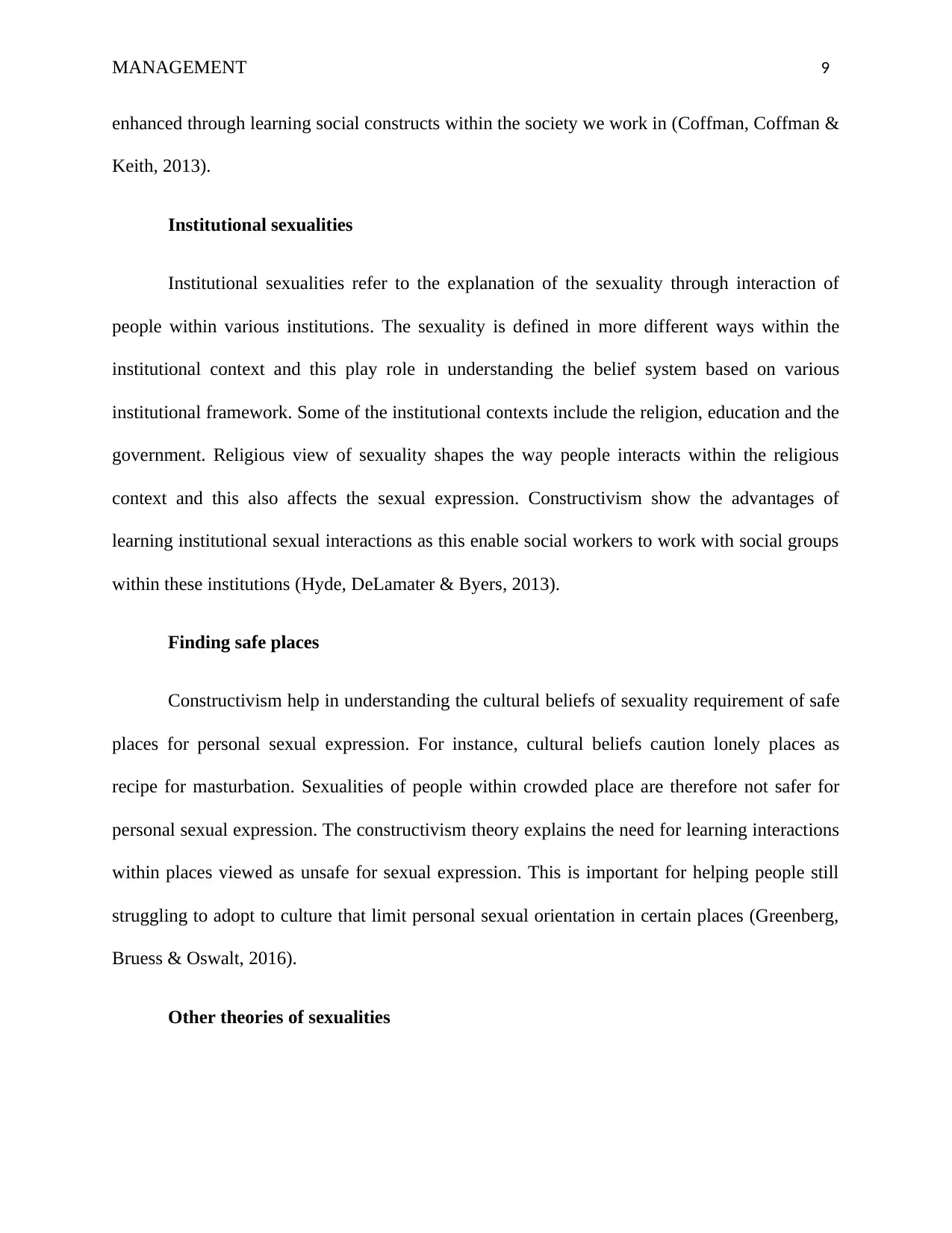
MANAGEMENT 9
enhanced through learning social constructs within the society we work in (Coffman, Coffman &
Keith, 2013).
Institutional sexualities
Institutional sexualities refer to the explanation of the sexuality through interaction of
people within various institutions. The sexuality is defined in more different ways within the
institutional context and this play role in understanding the belief system based on various
institutional framework. Some of the institutional contexts include the religion, education and the
government. Religious view of sexuality shapes the way people interacts within the religious
context and this also affects the sexual expression. Constructivism show the advantages of
learning institutional sexual interactions as this enable social workers to work with social groups
within these institutions (Hyde, DeLamater & Byers, 2013).
Finding safe places
Constructivism help in understanding the cultural beliefs of sexuality requirement of safe
places for personal sexual expression. For instance, cultural beliefs caution lonely places as
recipe for masturbation. Sexualities of people within crowded place are therefore not safer for
personal sexual expression. The constructivism theory explains the need for learning interactions
within places viewed as unsafe for sexual expression. This is important for helping people still
struggling to adopt to culture that limit personal sexual orientation in certain places (Greenberg,
Bruess & Oswalt, 2016).
Other theories of sexualities
enhanced through learning social constructs within the society we work in (Coffman, Coffman &
Keith, 2013).
Institutional sexualities
Institutional sexualities refer to the explanation of the sexuality through interaction of
people within various institutions. The sexuality is defined in more different ways within the
institutional context and this play role in understanding the belief system based on various
institutional framework. Some of the institutional contexts include the religion, education and the
government. Religious view of sexuality shapes the way people interacts within the religious
context and this also affects the sexual expression. Constructivism show the advantages of
learning institutional sexual interactions as this enable social workers to work with social groups
within these institutions (Hyde, DeLamater & Byers, 2013).
Finding safe places
Constructivism help in understanding the cultural beliefs of sexuality requirement of safe
places for personal sexual expression. For instance, cultural beliefs caution lonely places as
recipe for masturbation. Sexualities of people within crowded place are therefore not safer for
personal sexual expression. The constructivism theory explains the need for learning interactions
within places viewed as unsafe for sexual expression. This is important for helping people still
struggling to adopt to culture that limit personal sexual orientation in certain places (Greenberg,
Bruess & Oswalt, 2016).
Other theories of sexualities
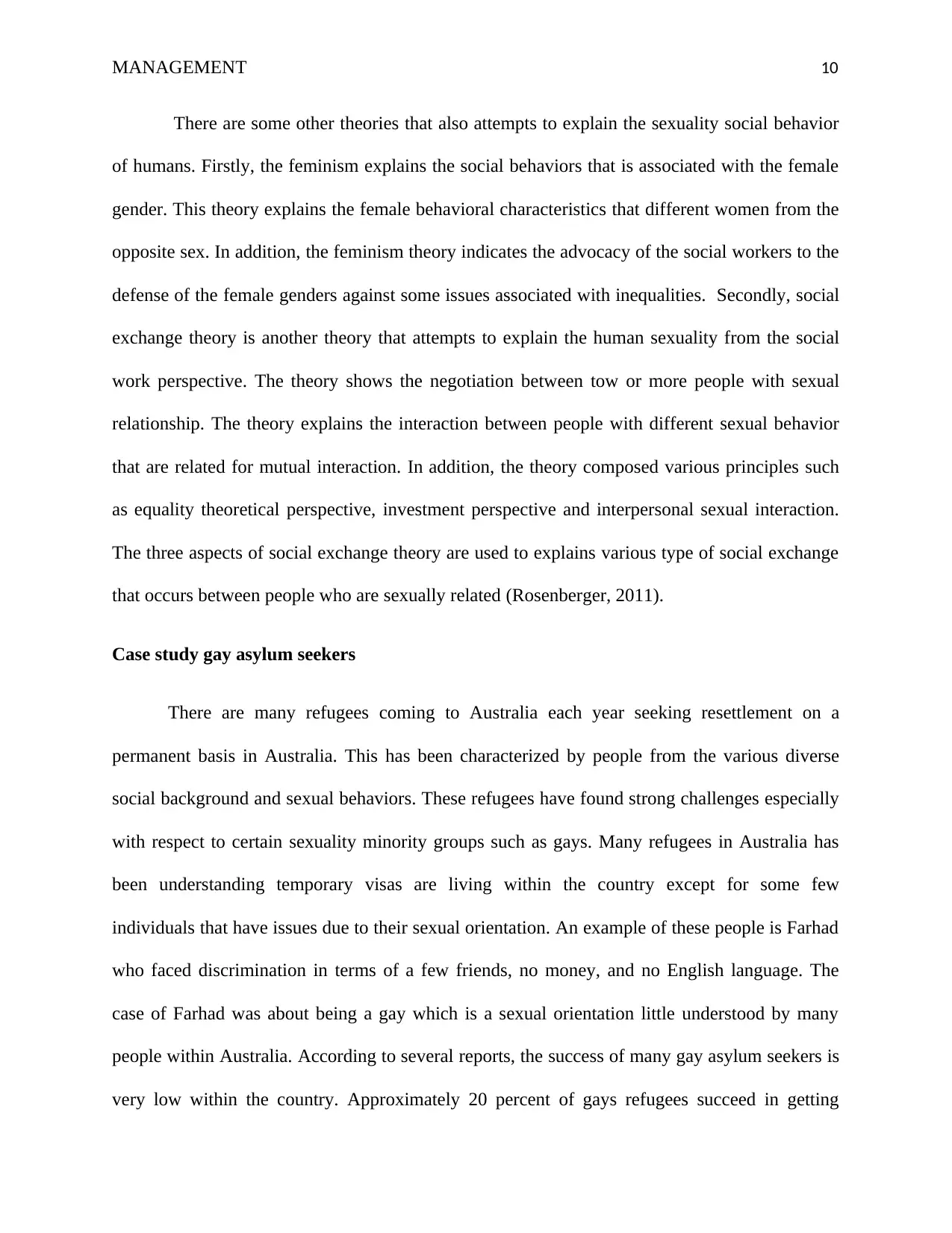
MANAGEMENT 10
There are some other theories that also attempts to explain the sexuality social behavior
of humans. Firstly, the feminism explains the social behaviors that is associated with the female
gender. This theory explains the female behavioral characteristics that different women from the
opposite sex. In addition, the feminism theory indicates the advocacy of the social workers to the
defense of the female genders against some issues associated with inequalities. Secondly, social
exchange theory is another theory that attempts to explain the human sexuality from the social
work perspective. The theory shows the negotiation between tow or more people with sexual
relationship. The theory explains the interaction between people with different sexual behavior
that are related for mutual interaction. In addition, the theory composed various principles such
as equality theoretical perspective, investment perspective and interpersonal sexual interaction.
The three aspects of social exchange theory are used to explains various type of social exchange
that occurs between people who are sexually related (Rosenberger, 2011).
Case study gay asylum seekers
There are many refugees coming to Australia each year seeking resettlement on a
permanent basis in Australia. This has been characterized by people from the various diverse
social background and sexual behaviors. These refugees have found strong challenges especially
with respect to certain sexuality minority groups such as gays. Many refugees in Australia has
been understanding temporary visas are living within the country except for some few
individuals that have issues due to their sexual orientation. An example of these people is Farhad
who faced discrimination in terms of a few friends, no money, and no English language. The
case of Farhad was about being a gay which is a sexual orientation little understood by many
people within Australia. According to several reports, the success of many gay asylum seekers is
very low within the country. Approximately 20 percent of gays refugees succeed in getting
There are some other theories that also attempts to explain the sexuality social behavior
of humans. Firstly, the feminism explains the social behaviors that is associated with the female
gender. This theory explains the female behavioral characteristics that different women from the
opposite sex. In addition, the feminism theory indicates the advocacy of the social workers to the
defense of the female genders against some issues associated with inequalities. Secondly, social
exchange theory is another theory that attempts to explain the human sexuality from the social
work perspective. The theory shows the negotiation between tow or more people with sexual
relationship. The theory explains the interaction between people with different sexual behavior
that are related for mutual interaction. In addition, the theory composed various principles such
as equality theoretical perspective, investment perspective and interpersonal sexual interaction.
The three aspects of social exchange theory are used to explains various type of social exchange
that occurs between people who are sexually related (Rosenberger, 2011).
Case study gay asylum seekers
There are many refugees coming to Australia each year seeking resettlement on a
permanent basis in Australia. This has been characterized by people from the various diverse
social background and sexual behaviors. These refugees have found strong challenges especially
with respect to certain sexuality minority groups such as gays. Many refugees in Australia has
been understanding temporary visas are living within the country except for some few
individuals that have issues due to their sexual orientation. An example of these people is Farhad
who faced discrimination in terms of a few friends, no money, and no English language. The
case of Farhad was about being a gay which is a sexual orientation little understood by many
people within Australia. According to several reports, the success of many gay asylum seekers is
very low within the country. Approximately 20 percent of gays refugees succeed in getting
Secure Best Marks with AI Grader
Need help grading? Try our AI Grader for instant feedback on your assignments.
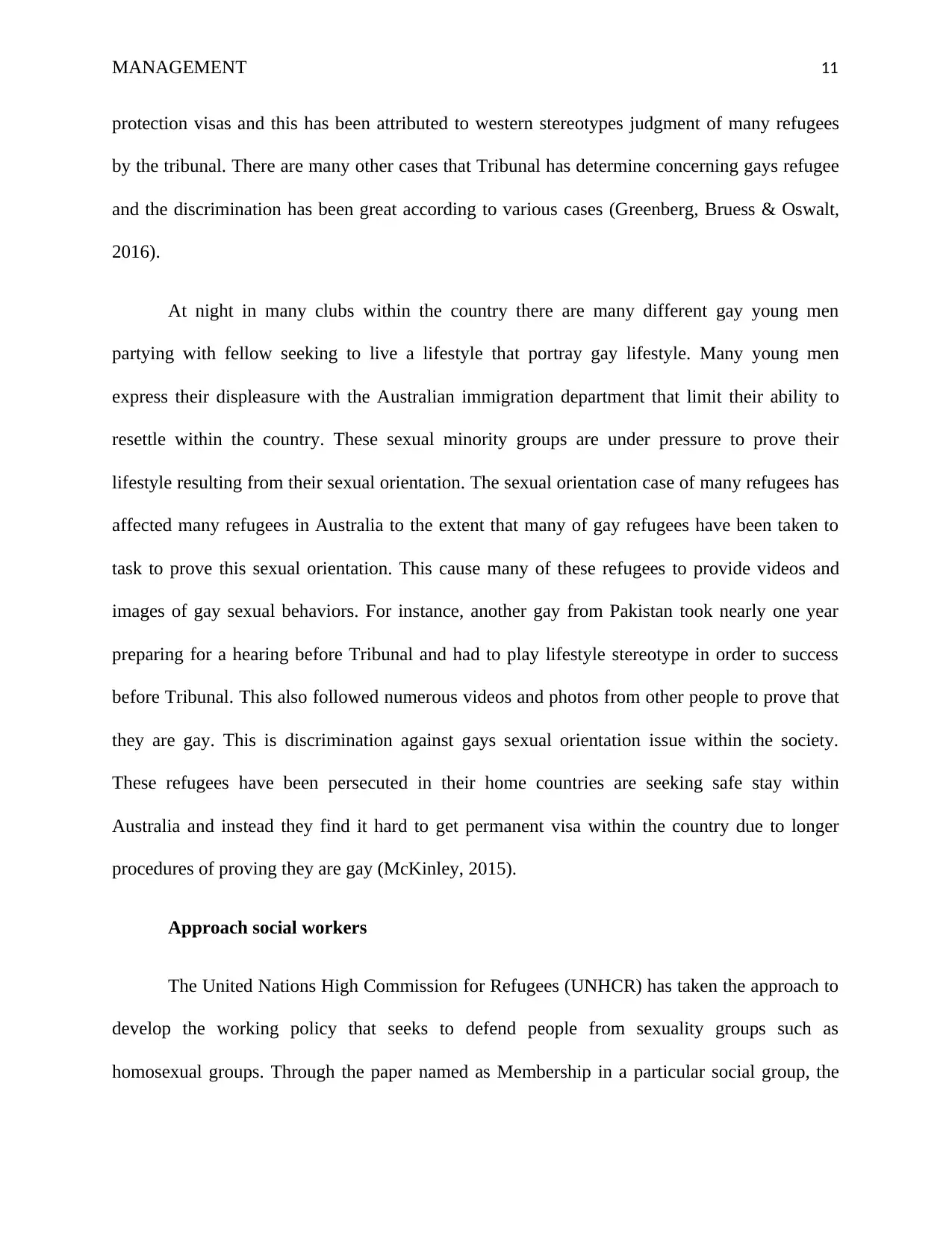
MANAGEMENT 11
protection visas and this has been attributed to western stereotypes judgment of many refugees
by the tribunal. There are many other cases that Tribunal has determine concerning gays refugee
and the discrimination has been great according to various cases (Greenberg, Bruess & Oswalt,
2016).
At night in many clubs within the country there are many different gay young men
partying with fellow seeking to live a lifestyle that portray gay lifestyle. Many young men
express their displeasure with the Australian immigration department that limit their ability to
resettle within the country. These sexual minority groups are under pressure to prove their
lifestyle resulting from their sexual orientation. The sexual orientation case of many refugees has
affected many refugees in Australia to the extent that many of gay refugees have been taken to
task to prove this sexual orientation. This cause many of these refugees to provide videos and
images of gay sexual behaviors. For instance, another gay from Pakistan took nearly one year
preparing for a hearing before Tribunal and had to play lifestyle stereotype in order to success
before Tribunal. This also followed numerous videos and photos from other people to prove that
they are gay. This is discrimination against gays sexual orientation issue within the society.
These refugees have been persecuted in their home countries are seeking safe stay within
Australia and instead they find it hard to get permanent visa within the country due to longer
procedures of proving they are gay (McKinley, 2015).
Approach social workers
The United Nations High Commission for Refugees (UNHCR) has taken the approach to
develop the working policy that seeks to defend people from sexuality groups such as
homosexual groups. Through the paper named as Membership in a particular social group, the
protection visas and this has been attributed to western stereotypes judgment of many refugees
by the tribunal. There are many other cases that Tribunal has determine concerning gays refugee
and the discrimination has been great according to various cases (Greenberg, Bruess & Oswalt,
2016).
At night in many clubs within the country there are many different gay young men
partying with fellow seeking to live a lifestyle that portray gay lifestyle. Many young men
express their displeasure with the Australian immigration department that limit their ability to
resettle within the country. These sexual minority groups are under pressure to prove their
lifestyle resulting from their sexual orientation. The sexual orientation case of many refugees has
affected many refugees in Australia to the extent that many of gay refugees have been taken to
task to prove this sexual orientation. This cause many of these refugees to provide videos and
images of gay sexual behaviors. For instance, another gay from Pakistan took nearly one year
preparing for a hearing before Tribunal and had to play lifestyle stereotype in order to success
before Tribunal. This also followed numerous videos and photos from other people to prove that
they are gay. This is discrimination against gays sexual orientation issue within the society.
These refugees have been persecuted in their home countries are seeking safe stay within
Australia and instead they find it hard to get permanent visa within the country due to longer
procedures of proving they are gay (McKinley, 2015).
Approach social workers
The United Nations High Commission for Refugees (UNHCR) has taken the approach to
develop the working policy that seeks to defend people from sexuality groups such as
homosexual groups. Through the paper named as Membership in a particular social group, the
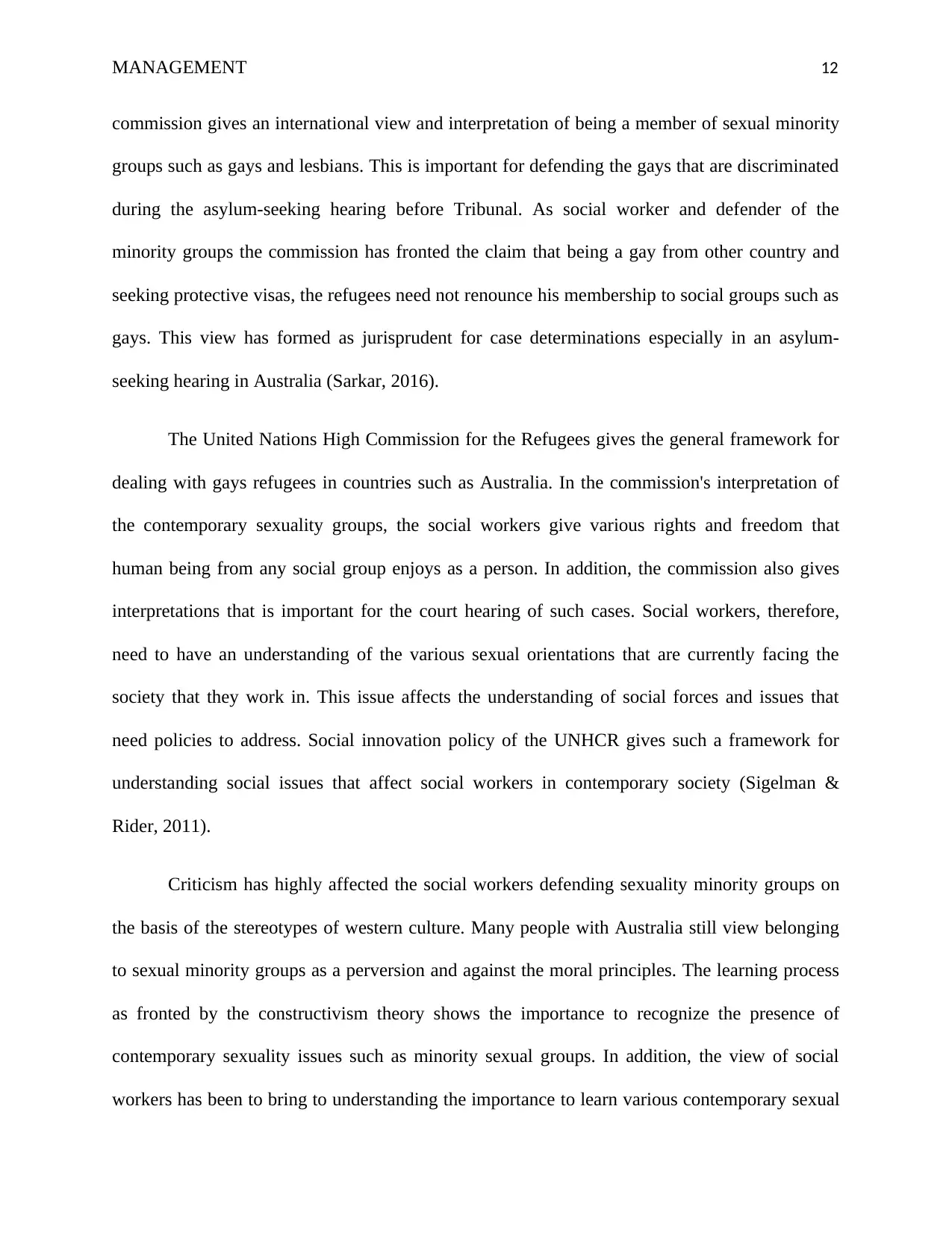
MANAGEMENT 12
commission gives an international view and interpretation of being a member of sexual minority
groups such as gays and lesbians. This is important for defending the gays that are discriminated
during the asylum-seeking hearing before Tribunal. As social worker and defender of the
minority groups the commission has fronted the claim that being a gay from other country and
seeking protective visas, the refugees need not renounce his membership to social groups such as
gays. This view has formed as jurisprudent for case determinations especially in an asylum-
seeking hearing in Australia (Sarkar, 2016).
The United Nations High Commission for the Refugees gives the general framework for
dealing with gays refugees in countries such as Australia. In the commission's interpretation of
the contemporary sexuality groups, the social workers give various rights and freedom that
human being from any social group enjoys as a person. In addition, the commission also gives
interpretations that is important for the court hearing of such cases. Social workers, therefore,
need to have an understanding of the various sexual orientations that are currently facing the
society that they work in. This issue affects the understanding of social forces and issues that
need policies to address. Social innovation policy of the UNHCR gives such a framework for
understanding social issues that affect social workers in contemporary society (Sigelman &
Rider, 2011).
Criticism has highly affected the social workers defending sexuality minority groups on
the basis of the stereotypes of western culture. Many people with Australia still view belonging
to sexual minority groups as a perversion and against the moral principles. The learning process
as fronted by the constructivism theory shows the importance to recognize the presence of
contemporary sexuality issues such as minority sexual groups. In addition, the view of social
workers has been to bring to understanding the importance to learn various contemporary sexual
commission gives an international view and interpretation of being a member of sexual minority
groups such as gays and lesbians. This is important for defending the gays that are discriminated
during the asylum-seeking hearing before Tribunal. As social worker and defender of the
minority groups the commission has fronted the claim that being a gay from other country and
seeking protective visas, the refugees need not renounce his membership to social groups such as
gays. This view has formed as jurisprudent for case determinations especially in an asylum-
seeking hearing in Australia (Sarkar, 2016).
The United Nations High Commission for the Refugees gives the general framework for
dealing with gays refugees in countries such as Australia. In the commission's interpretation of
the contemporary sexuality groups, the social workers give various rights and freedom that
human being from any social group enjoys as a person. In addition, the commission also gives
interpretations that is important for the court hearing of such cases. Social workers, therefore,
need to have an understanding of the various sexual orientations that are currently facing the
society that they work in. This issue affects the understanding of social forces and issues that
need policies to address. Social innovation policy of the UNHCR gives such a framework for
understanding social issues that affect social workers in contemporary society (Sigelman &
Rider, 2011).
Criticism has highly affected the social workers defending sexuality minority groups on
the basis of the stereotypes of western culture. Many people with Australia still view belonging
to sexual minority groups as a perversion and against the moral principles. The learning process
as fronted by the constructivism theory shows the importance to recognize the presence of
contemporary sexuality issues such as minority sexual groups. In addition, the view of social
workers has been to bring to understanding the importance to learn various contemporary sexual
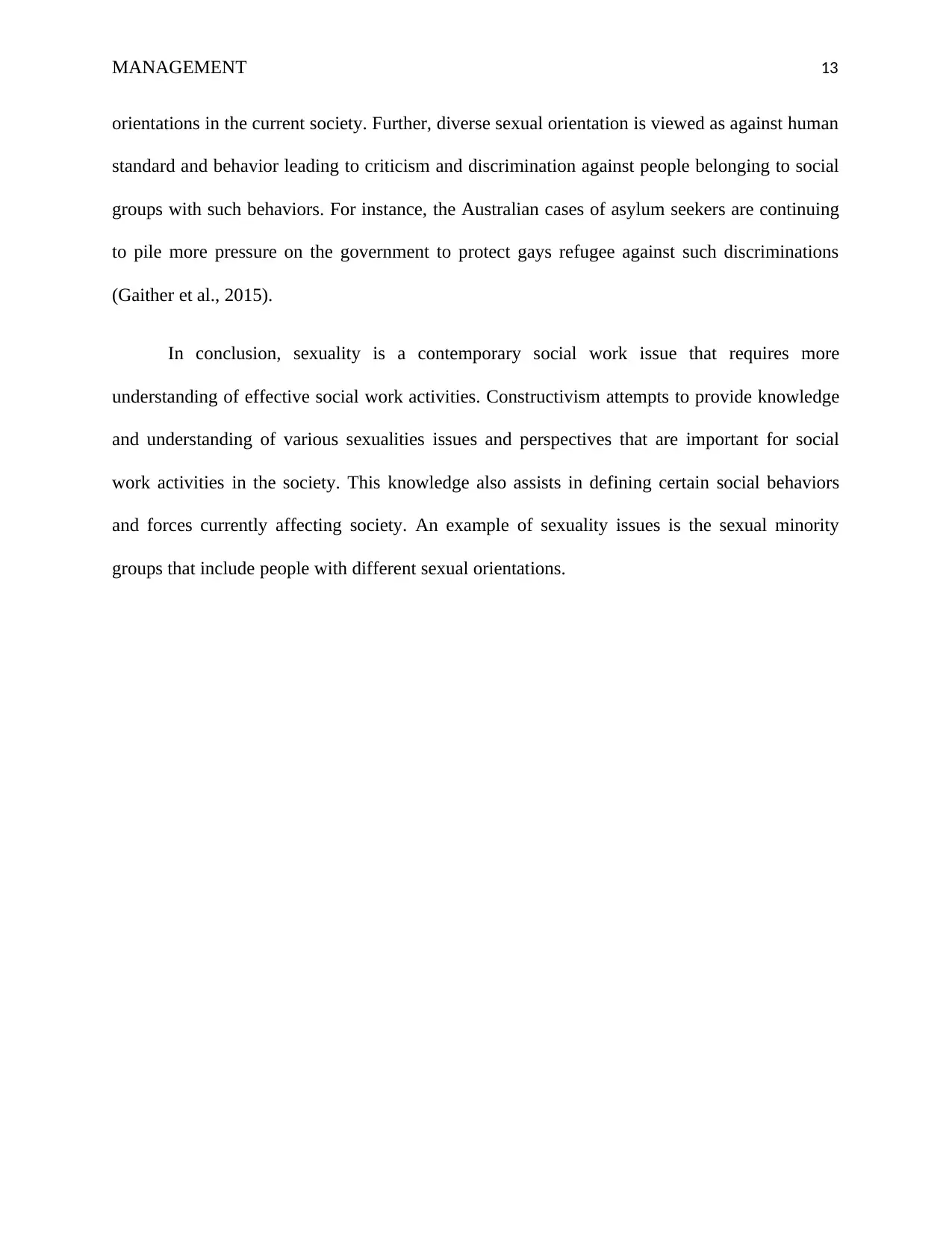
MANAGEMENT 13
orientations in the current society. Further, diverse sexual orientation is viewed as against human
standard and behavior leading to criticism and discrimination against people belonging to social
groups with such behaviors. For instance, the Australian cases of asylum seekers are continuing
to pile more pressure on the government to protect gays refugee against such discriminations
(Gaither et al., 2015).
In conclusion, sexuality is a contemporary social work issue that requires more
understanding of effective social work activities. Constructivism attempts to provide knowledge
and understanding of various sexualities issues and perspectives that are important for social
work activities in the society. This knowledge also assists in defining certain social behaviors
and forces currently affecting society. An example of sexuality issues is the sexual minority
groups that include people with different sexual orientations.
orientations in the current society. Further, diverse sexual orientation is viewed as against human
standard and behavior leading to criticism and discrimination against people belonging to social
groups with such behaviors. For instance, the Australian cases of asylum seekers are continuing
to pile more pressure on the government to protect gays refugee against such discriminations
(Gaither et al., 2015).
In conclusion, sexuality is a contemporary social work issue that requires more
understanding of effective social work activities. Constructivism attempts to provide knowledge
and understanding of various sexualities issues and perspectives that are important for social
work activities in the society. This knowledge also assists in defining certain social behaviors
and forces currently affecting society. An example of sexuality issues is the sexual minority
groups that include people with different sexual orientations.
Paraphrase This Document
Need a fresh take? Get an instant paraphrase of this document with our AI Paraphraser
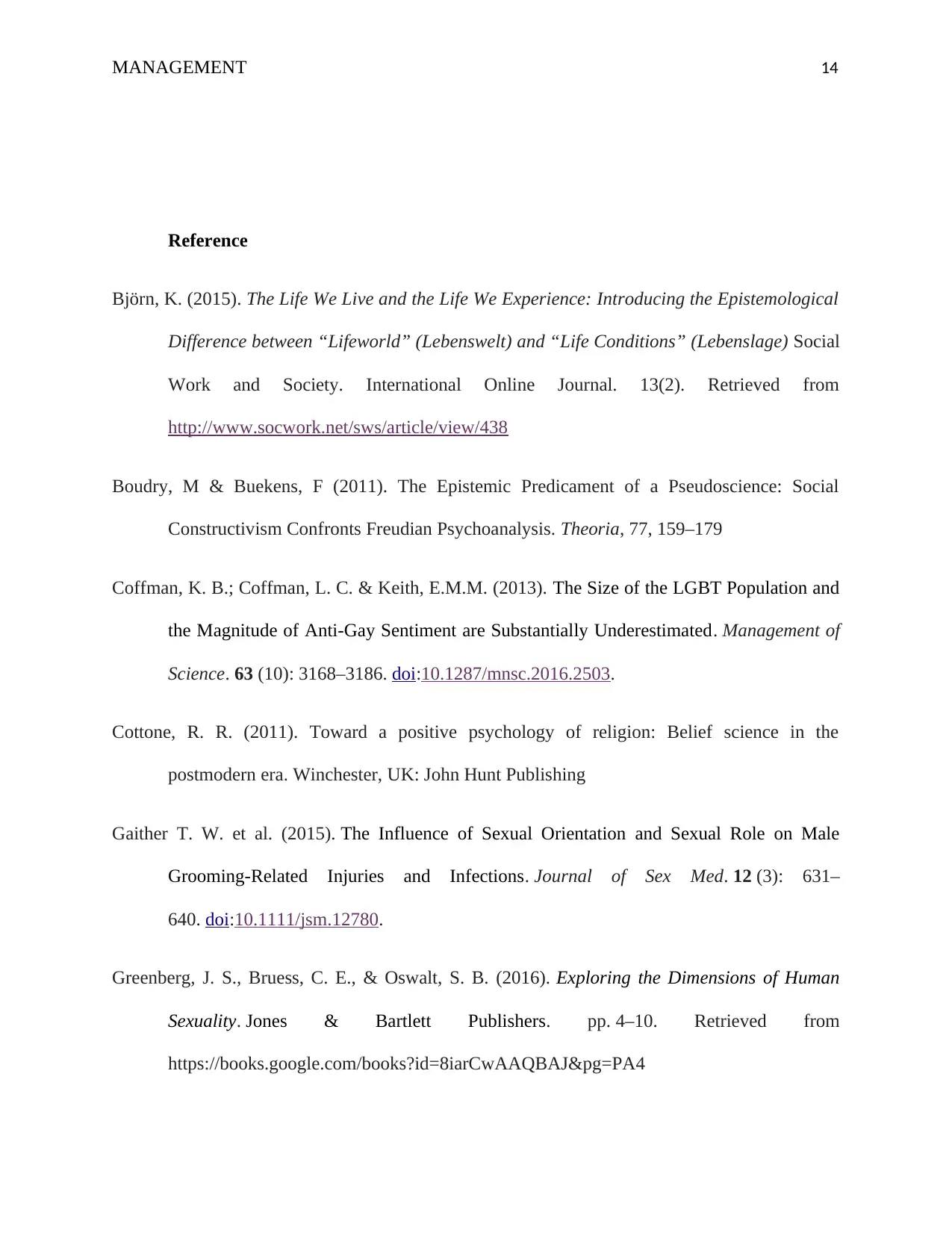
MANAGEMENT 14
Reference
Björn, K. (2015). The Life We Live and the Life We Experience: Introducing the Epistemological
Difference between “Lifeworld” (Lebenswelt) and “Life Conditions” (Lebenslage) Social
Work and Society. International Online Journal. 13(2). Retrieved from
http://www.socwork.net/sws/article/view/438
Boudry, M & Buekens, F (2011). The Epistemic Predicament of a Pseudoscience: Social
Constructivism Confronts Freudian Psychoanalysis. Theoria, 77, 159–179
Coffman, K. B.; Coffman, L. C. & Keith, E.M.M. (2013). The Size of the LGBT Population and
the Magnitude of Anti-Gay Sentiment are Substantially Underestimated. Management of
Science. 63 (10): 3168–3186. doi:10.1287/mnsc.2016.2503.
Cottone, R. R. (2011). Toward a positive psychology of religion: Belief science in the
postmodern era. Winchester, UK: John Hunt Publishing
Gaither T. W. et al. (2015). The Influence of Sexual Orientation and Sexual Role on Male
Grooming-Related Injuries and Infections. Journal of Sex Med. 12 (3): 631–
640. doi:10.1111/jsm.12780.
Greenberg, J. S., Bruess, C. E., & Oswalt, S. B. (2016). Exploring the Dimensions of Human
Sexuality. Jones & Bartlett Publishers. pp. 4–10. Retrieved from
https://books.google.com/books?id=8iarCwAAQBAJ&pg=PA4
Reference
Björn, K. (2015). The Life We Live and the Life We Experience: Introducing the Epistemological
Difference between “Lifeworld” (Lebenswelt) and “Life Conditions” (Lebenslage) Social
Work and Society. International Online Journal. 13(2). Retrieved from
http://www.socwork.net/sws/article/view/438
Boudry, M & Buekens, F (2011). The Epistemic Predicament of a Pseudoscience: Social
Constructivism Confronts Freudian Psychoanalysis. Theoria, 77, 159–179
Coffman, K. B.; Coffman, L. C. & Keith, E.M.M. (2013). The Size of the LGBT Population and
the Magnitude of Anti-Gay Sentiment are Substantially Underestimated. Management of
Science. 63 (10): 3168–3186. doi:10.1287/mnsc.2016.2503.
Cottone, R. R. (2011). Toward a positive psychology of religion: Belief science in the
postmodern era. Winchester, UK: John Hunt Publishing
Gaither T. W. et al. (2015). The Influence of Sexual Orientation and Sexual Role on Male
Grooming-Related Injuries and Infections. Journal of Sex Med. 12 (3): 631–
640. doi:10.1111/jsm.12780.
Greenberg, J. S., Bruess, C. E., & Oswalt, S. B. (2016). Exploring the Dimensions of Human
Sexuality. Jones & Bartlett Publishers. pp. 4–10. Retrieved from
https://books.google.com/books?id=8iarCwAAQBAJ&pg=PA4
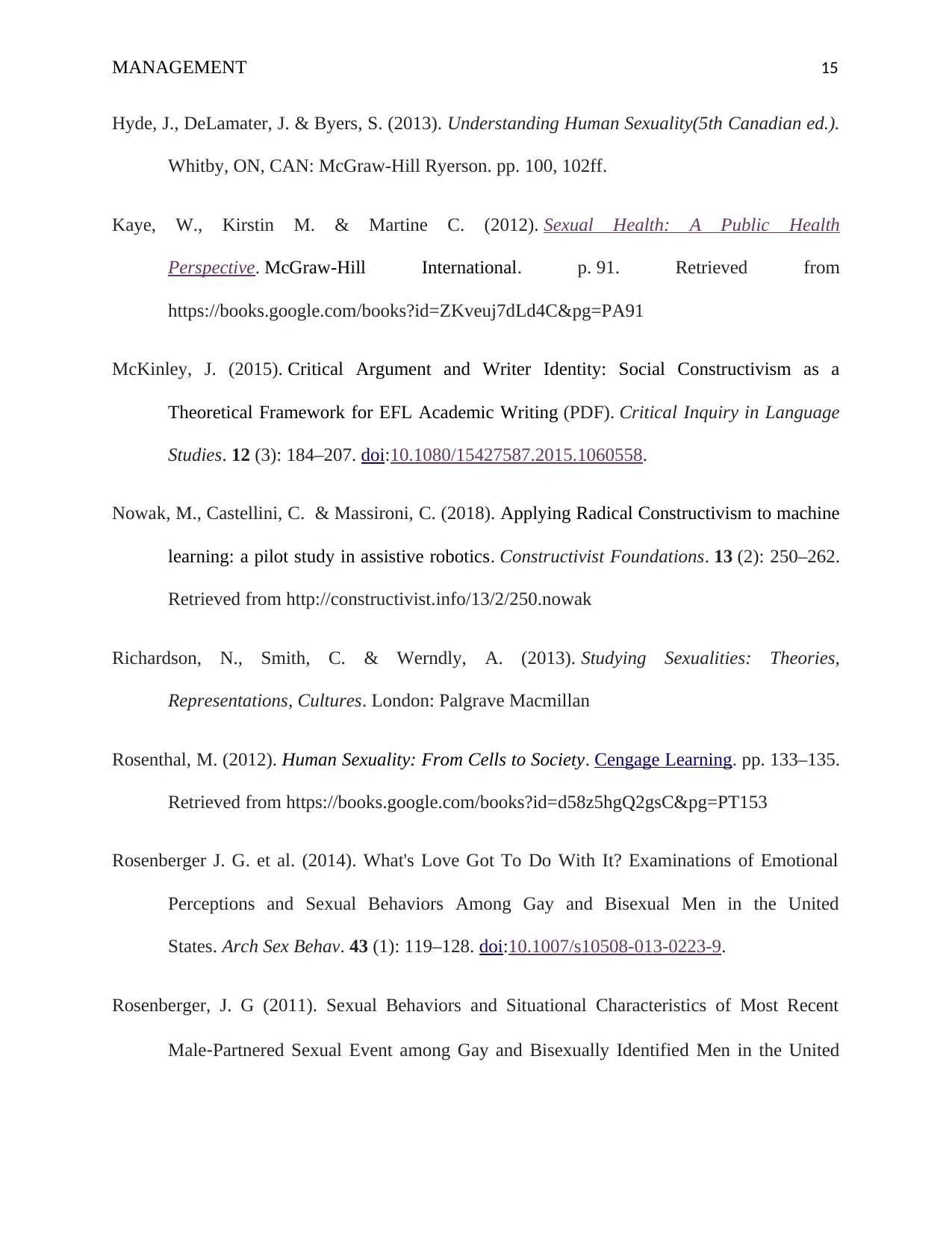
MANAGEMENT 15
Hyde, J., DeLamater, J. & Byers, S. (2013). Understanding Human Sexuality(5th Canadian ed.).
Whitby, ON, CAN: McGraw-Hill Ryerson. pp. 100, 102ff.
Kaye, W., Kirstin M. & Martine C. (2012). Sexual Health: A Public Health
Perspective. McGraw-Hill International. p. 91. Retrieved from
https://books.google.com/books?id=ZKveuj7dLd4C&pg=PA91
McKinley, J. (2015). Critical Argument and Writer Identity: Social Constructivism as a
Theoretical Framework for EFL Academic Writing (PDF). Critical Inquiry in Language
Studies. 12 (3): 184–207. doi:10.1080/15427587.2015.1060558.
Nowak, M., Castellini, C. & Massironi, C. (2018). Applying Radical Constructivism to machine
learning: a pilot study in assistive robotics. Constructivist Foundations. 13 (2): 250–262.
Retrieved from http://constructivist.info/13/2/250.nowak
Richardson, N., Smith, C. & Werndly, A. (2013). Studying Sexualities: Theories,
Representations, Cultures. London: Palgrave Macmillan
Rosenthal, M. (2012). Human Sexuality: From Cells to Society. Cengage Learning. pp. 133–135.
Retrieved from https://books.google.com/books?id=d58z5hgQ2gsC&pg=PT153
Rosenberger J. G. et al. (2014). What's Love Got To Do With It? Examinations of Emotional
Perceptions and Sexual Behaviors Among Gay and Bisexual Men in the United
States. Arch Sex Behav. 43 (1): 119–128. doi:10.1007/s10508-013-0223-9.
Rosenberger, J. G (2011). Sexual Behaviors and Situational Characteristics of Most Recent
Male‐Partnered Sexual Event among Gay and Bisexually Identified Men in the United
Hyde, J., DeLamater, J. & Byers, S. (2013). Understanding Human Sexuality(5th Canadian ed.).
Whitby, ON, CAN: McGraw-Hill Ryerson. pp. 100, 102ff.
Kaye, W., Kirstin M. & Martine C. (2012). Sexual Health: A Public Health
Perspective. McGraw-Hill International. p. 91. Retrieved from
https://books.google.com/books?id=ZKveuj7dLd4C&pg=PA91
McKinley, J. (2015). Critical Argument and Writer Identity: Social Constructivism as a
Theoretical Framework for EFL Academic Writing (PDF). Critical Inquiry in Language
Studies. 12 (3): 184–207. doi:10.1080/15427587.2015.1060558.
Nowak, M., Castellini, C. & Massironi, C. (2018). Applying Radical Constructivism to machine
learning: a pilot study in assistive robotics. Constructivist Foundations. 13 (2): 250–262.
Retrieved from http://constructivist.info/13/2/250.nowak
Richardson, N., Smith, C. & Werndly, A. (2013). Studying Sexualities: Theories,
Representations, Cultures. London: Palgrave Macmillan
Rosenthal, M. (2012). Human Sexuality: From Cells to Society. Cengage Learning. pp. 133–135.
Retrieved from https://books.google.com/books?id=d58z5hgQ2gsC&pg=PT153
Rosenberger J. G. et al. (2014). What's Love Got To Do With It? Examinations of Emotional
Perceptions and Sexual Behaviors Among Gay and Bisexual Men in the United
States. Arch Sex Behav. 43 (1): 119–128. doi:10.1007/s10508-013-0223-9.
Rosenberger, J. G (2011). Sexual Behaviors and Situational Characteristics of Most Recent
Male‐Partnered Sexual Event among Gay and Bisexually Identified Men in the United
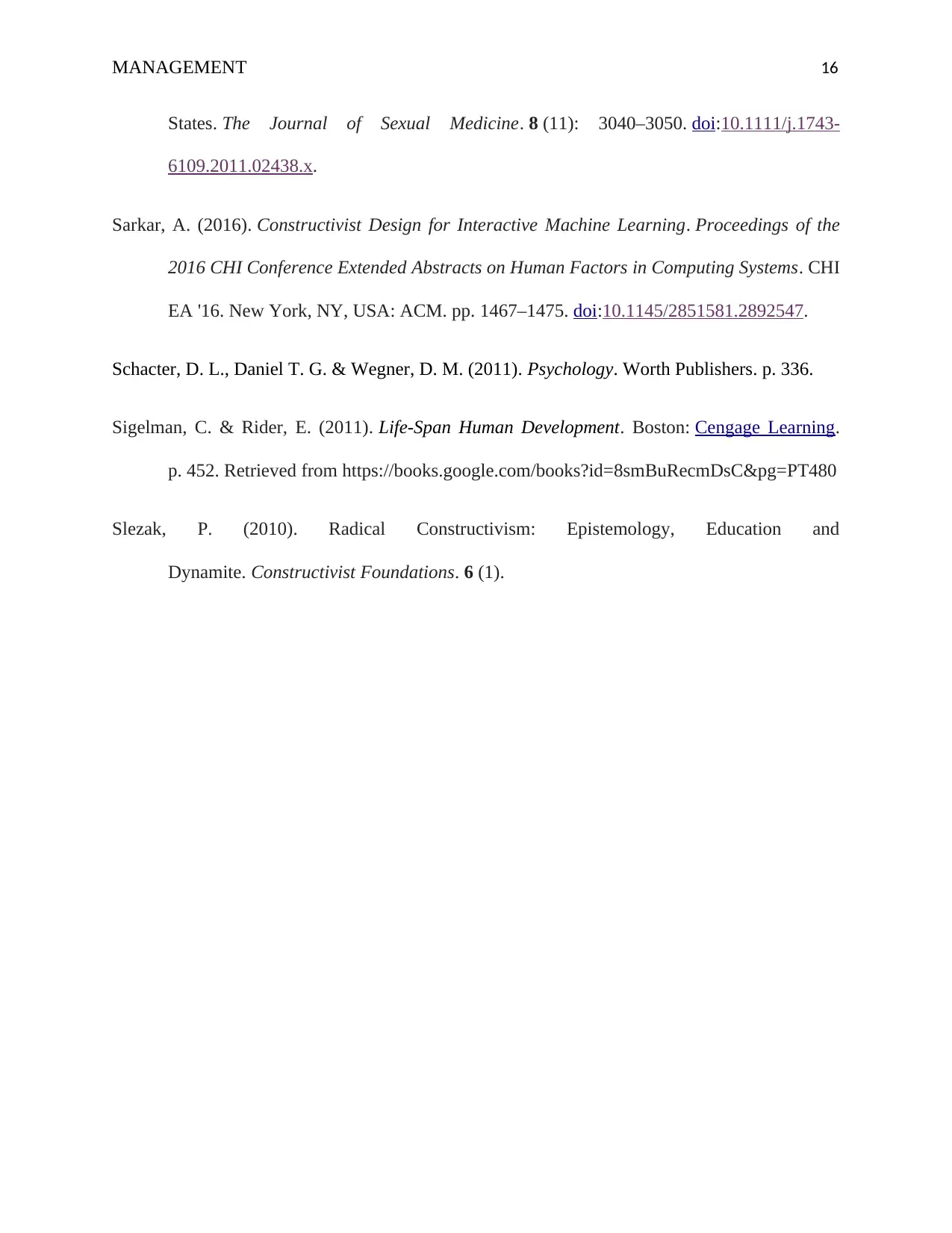
MANAGEMENT 16
States. The Journal of Sexual Medicine. 8 (11): 3040–3050. doi:10.1111/j.1743-
6109.2011.02438.x.
Sarkar, A. (2016). Constructivist Design for Interactive Machine Learning. Proceedings of the
2016 CHI Conference Extended Abstracts on Human Factors in Computing Systems. CHI
EA '16. New York, NY, USA: ACM. pp. 1467–1475. doi:10.1145/2851581.2892547.
Schacter, D. L., Daniel T. G. & Wegner, D. M. (2011). Psychology. Worth Publishers. p. 336.
Sigelman, C. & Rider, E. (2011). Life-Span Human Development. Boston: Cengage Learning.
p. 452. Retrieved from https://books.google.com/books?id=8smBuRecmDsC&pg=PT480
Slezak, P. (2010). Radical Constructivism: Epistemology, Education and
Dynamite. Constructivist Foundations. 6 (1).
States. The Journal of Sexual Medicine. 8 (11): 3040–3050. doi:10.1111/j.1743-
6109.2011.02438.x.
Sarkar, A. (2016). Constructivist Design for Interactive Machine Learning. Proceedings of the
2016 CHI Conference Extended Abstracts on Human Factors in Computing Systems. CHI
EA '16. New York, NY, USA: ACM. pp. 1467–1475. doi:10.1145/2851581.2892547.
Schacter, D. L., Daniel T. G. & Wegner, D. M. (2011). Psychology. Worth Publishers. p. 336.
Sigelman, C. & Rider, E. (2011). Life-Span Human Development. Boston: Cengage Learning.
p. 452. Retrieved from https://books.google.com/books?id=8smBuRecmDsC&pg=PT480
Slezak, P. (2010). Radical Constructivism: Epistemology, Education and
Dynamite. Constructivist Foundations. 6 (1).
Secure Best Marks with AI Grader
Need help grading? Try our AI Grader for instant feedback on your assignments.

MANAGEMENT 17
1 out of 17
Related Documents
Your All-in-One AI-Powered Toolkit for Academic Success.
+13062052269
info@desklib.com
Available 24*7 on WhatsApp / Email
![[object Object]](/_next/static/media/star-bottom.7253800d.svg)
Unlock your academic potential
© 2024 | Zucol Services PVT LTD | All rights reserved.





